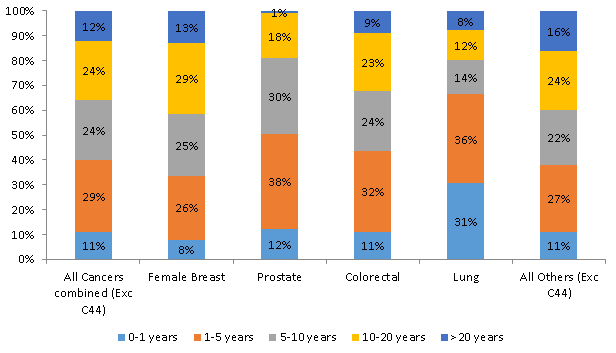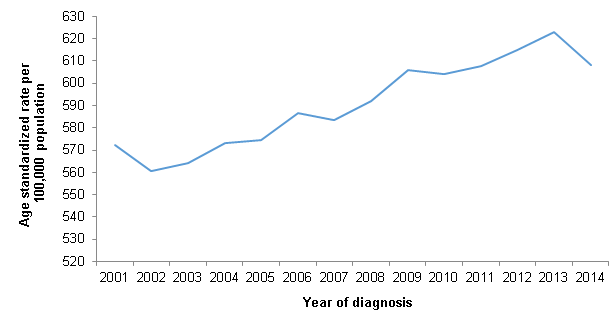Today at the PHE conference the National Cancer Registration and Analysis Service (NCRAS), in partnership with Macmillan Cancer Support, released new figures showing that there were 1.87 million people living with and beyond a cancer diagnosis in England at the end of 2013.
Previous research estimated that at the end of 2008 there were 1.66 million people living in England after a cancer diagnosis . The new analyses suggest that in 5 years the cancer population has increased by 200,000.
Why is this important?
Accurately knowing exactly how many people have or have had cancer and how that is growing is vital to the NHS, charities and government when assessing the country’s health needs.
Today’s news has huge implications for commissioning, treatment and end of life care across health and social care. More and more people are living longer but with co-morbidities, a fact further highlighted today by the release of PHE’s new diabetes prevalence data.
This work is a continuation of the partnership work programme between NCRAS and Macmillan Cancer Support which previously published the 20-year prevalence of cancer in the UK.
How do you calculate prevalence?
The analysis used cancer registry data based on residents in England diagnosed between 1971 and 2013 to count the number of people diagnosed with cancer who were still alive on 31 December 2013.
A process of negative binomial regression was then used to estimate the prevalence of patients diagnosed before 1971, enabling the calculation of complete prevalence*.
The data released today is available for the whole of the UK by country, sex and age at diagnosis for the four most common incident cancers; female breast, prostate, colorectal and lung cancer along with “all other cancers” (excluding non-melanoma skin cancer).
How do the figures break down?
The annual number of new cases for both female breast cancer and lung cancer in England are relatively similar (46,100 and 37,500 respectively in 2014), however, when looking at the number of people still alive in 2013 after receiving a diagnosis of either female breast or lung cancer it is easy to see the stark contrast in situation for people diagnosed with different cancers.
These data show that there were nearly 500,000 women living after a breast cancer diagnosis in England at the end of 2013 compared to just over 50,000 people for lung cancer.
Large differences between different cancers in the time since diagnosis can also be seen in the population of people living after a cancer diagnosis (as shown in the graph below): across all tumour sites 60% of people have lived over 5 years after their cancer diagnosis, however for lung and prostate cancer only 34% and 49% respectively of patients who are still alive at the end of 2013 have survived over 5 years. This is in contrast to 67% for breast cancer.
Again this highlights the contrast in needs for patients with different cancers – the majority of people living after a diagnosis of prostate or lung cancer are still in what could be perceived as the main treatment period of care (0-5 years after diagnosis), whereas over 60% of people diagnosed with female breast and 50% of people diagnosed with colorectal cancer are in the “after treatment” phase of care and often have completely different needs.
These data allow us to gain an understanding of the number of people facing the different challenges that come hand in hand with a cancer diagnosis.

Cancer incidence rates in England are also rising (see below). Coupling this with the improvements in cancer survival and a growing and ageing population mean a similar if not bigger rise in the prevalence of cancer is expected in the years to come.
Macmillan Cancer Support has estimated that in England there are around 2 million people living with cancer in 2015 which is in line with these 2013 prevalence estimates.

NHS cancer strategy
Understanding and reacting to the growth of the cancer population in England is fundamental to achieving the world class outcomes as set out in the NHS Cancer Strategy. These new results will be essential to ensuring to delivering the priorities on transforming our approach to living with and beyond cancer in particular.
It also emphasises the importance of putting patient experience on a par with clinical effectiveness, given the increasing number of people directly dealing with the disease and its consequences.
Of course prevention lies at the heart of PHE’s responsibilities in delivering the strategy and reducing incidence. We are working with our partners like the NHS and local authorities on tackling the risk factors for cancer and many other diseases.
For example, guidance on healthy levels of sugar, public health campaigns like One You to tackle obesity; campaigns like Stoptober and evidence reviews on e-cigarettes on smoking; programmes to help people take control of their health like the NHS Health Check and the diabetes prevention programme amongst a host of other work.
We will continue to work with partners like Macmillan and NHS to create products, and data like this that will help deliver on these priorities.
*Data for U.K. figures used cancer registration data from the cancer registries of England, Northern Ireland, Scotland and Wales. Details on data availability are available in the corresponding technical report found at http://www.ncin.org.uk/about_ncin/segmentation

